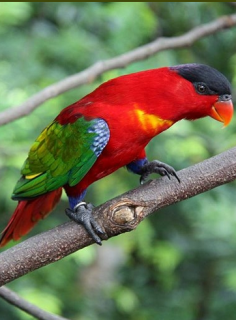Purple-naped Lory |
|
|
Also known as: Purple-capped Lory
Photos
View in GalleryDid You Know?
Lories and lorikeets are small to medium-sized parrots known for their specialized brush-tipped tongues for feeding on nectar of various blossoms.Academic Research
Related publications: Lorius domicellaSpecies Profile
Genus: Lorius | Species: domicella
Size:
28cm (11 in)
Weight:
235g (8.2 oz)
Subspecies including nominate:
one
Colour Adult:
Both adults in general red; black forehead and lores to occiput, with purple patch bordering from behind; upper breast has yellow band which varies from bird to bird; purple/blue thighs; green wings; yellow underwing-band; red tail, tipped with darker brown/red. Bill orange. Eye ring dark grey. Eye orange/red.
Colour Juvenile:
As in adults but patch behind occiput more extensive and deeper purple; wider pectoral band; greater underwing coverts margined with black; faint blue tip on tail. Bill brown. Eye ring grey/white. Eye brown.
Call:
Calls are described as being melodious.
Listen NowMore Information:
Content Sources:
CITES
Wikipedia
BirdLife International
Cornell Lab of Ornithology/Birds of the World
A Guide to Parrots of the World, Juniper and Parr, 1998.
Parrots of the World, Forshaw, 2006. 2010 edition
Parrots of the World, Forshaw and Cooper, 1989.
Vanished and Vanishing Parrots, Forshaw, 2017.
Lexicon of Parrots, Thomas Arndt.
Parrots in Aviculture, Low, 1992.
ML Media Catalogue 518181 Purple-naped Lory Lorius domicella, DeCicco, Lucas, Maluku, Indonesia, Jan. 10 2016, Cornell Lab of Ornithology.
Photos
View in GalleryDid You Know?
Lories and lorikeets are small to medium-sized parrots known for their specialized brush-tipped tongues for feeding on nectar of various blossoms.Academic Research
Related publications: Lorius domicellaSpecies Care
Captive Status:
Rare
Longevity:
Not recorded.
Housing:
Aviary or suspended cage with well drained, tile surrounded floor.
Diet:
Nectar - either a commercial type or homemade from: lactose-free baby cereal, honey and malt extract or molasses, mixed with filtered water and with added wheat germ, if desired, and made fresh once or twice daily; fresh fruit once or twice daily, in particular apple, pear, orange, cactus fruits and bananas; one or more vegetables such as: carrot, fresh corn on the cob or tinned, unsalted sweet corn; green leaves such as: Swiss chard, lettuce, kale, dandelion, sowthistle, chickweed; rearing food made from: hard boiled egg, wholegrain bread and carrot, all ground to crumbly consistency.
Enrichment:
Not recorded.
Nest Box Size:
Diagonal nestbox 40cm x 20cm x 30cm (16 x 8 x 12 in).
Clutch Size:
2
Incubation Time:
24-26 days
Fledging Age:
About 11 weeks.
Hatch Weight:
Not recorded.
Peak Weight:
Not recorded.
Weaning Weight:
Not recorded.
Photos
View in GalleryDid You Know?
Lories and lorikeets are small to medium-sized parrots known for their specialized brush-tipped tongues for feeding on nectar of various blossoms.Academic Research
Related publications: Lorius domicellaSpecies Wild Status
World Population:
1000-2500 mature individuals.
IUCN Red List Status:
Endangered
CITES Listing:
Appendix II
Threat Summary:
A BirdLife “restricted-range” species. Apparently has a naturally low population; is uncommon to rare on Seram, with no recent reports from Ambon or Buru. Ongoing deforestation from logging, oil drilling and hydroelectric power plants and intensive trapping are suspected to be causing rapid declines.
Range:
Seram and may also occur on Ambon, S Moluccas, Indonesia. Introduced to Buru.
Habitat:
Found from 600-1000m (1968-3280 ft) in montane and submontane primary and secondary forest, lowland forest and in cultivated areas.
Wild Diet:
Feeds on fruits, nectar, pollen, seeds of rattan and berries.
Ecology and Behaviour:
Seen in pairs, rarely in groups, and may be territorial. Stays mainly in upper branches of tall trees. Quiet and shy while feeding and resting, but noisy and conspicuous while flying above the trees.
Clutch and Egg Size:
2 elliptical eggs, 31.5 x 25.0mm (1.2 x 1.0 in).
Breeding Season:
Not recorded.
Related Links:
Photos
View in GalleryDid You Know?
Lories and lorikeets are small to medium-sized parrots known for their specialized brush-tipped tongues for feeding on nectar of various blossoms.Academic Research
Related publications: Lorius domicellaMembers Only Resources
Please log-in now to find more research, resources and tools.
Not a Member?
Find more great information:
Gain exclusive access to 600+ pages of additional research, seminars and podcasts, specialists to ask your toughest questions, and dozens of other fun resources - when you become a WPT member.
Join Today >>

































